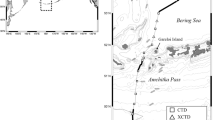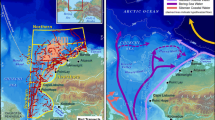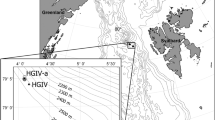Abstract
During June 1991, we studied sea birds at a mid-ocean seamount (Fieberling Guyot) in the eastern North Pacific Ocean. Avifaunal composition changed from small Procellariiformes [a storm-petrel; Oceanodroma leucorhoa (Vieillot)] away from the seamount to an assemblage dominated by larger tubenoses [mostly black-footed albatross Diomedea nigripes Audubon and Cook's petrel Pterodroma cookii (Gray)]. Compared to adjacent waters, sea-bird density and biomass within a 30-km radius centered on the seamount summit were 2.4 and 8 times higher, respectively. Individual sea-bird taxa were 2 to 40 times more abundant at the seamount relative to values reported previously from large-scale surveys of deep-ocean regions in the central North Pacific. In September 1991 we studied potential prey of sea birds in the upper water column using a neuston net and multiple opening-closing net system (MOCNESS) tows. Most potential prey types in the neuston exhibited no significant enhancement over the seamount. MOCNESS samples at 10 m depth, however, showed several prey types to be more abundant over the seamount, and the dominant size class of fish was slightly larger. We attribute the sea-bird aggregation observed at this seamount to changes in the abundance and/or behavior of pelagic organisms in the deep scattering layer (not adequately sampled in this study), perhaps augmented by migrations of seamount residents into the surface layers. Processes on and in the vicinity of seamounts may provide spatially-predictable prey to wide-ranging aerial sea birds foraging in this relatively austere environment.
Similar content being viewed by others
References
Au DWK, Pitman RL (1986) Seabird interactions with dolphins and tuna in the eastern tropical Pacific. Condor 88:304–317
Bartle JA, Hu D, Stahl JC, Pyle P, Simons TR, Woodby D (1993) Status and ecology of gadfly petrels in the temperate North Pacific. In: Vermeer K, Briggs KT, Morgan KH, Siegel-Causey D (eds) The status, ecology, and conservation of marine birds of the North Pacific. Canadian Wildlife Service Special Publication, Ottawa, pp 101–111
Blaber SJM (1986) The distribution and abundance of seabirds south-east of Tasmania and over the Soela Seamount during April 1985. Emu 86:239–244
Boehlert GW, Genin A (1987) A review of the effects of seamounts on biological processes. Geophys Monogr 43:319–334
Bourne WRP (1992) A concentration of great sheawaters and white-bellied storm-petrels over the RSA Seamount in the South Atlantic east of Gough Island. Sea Swallow 41:51–53
Briggs KT, Tyler WB, Lewis DB, Carlson dR (1987) Bird communities at sea off California: 1975 to 1983. Stud avian Biol 11:1–74
Brooke M deL, Prince PA (1989) Nocturnality in seabirds. Acta XX Congr int Ornithol: 1113–1121
Brown RGB (1988) The influence of oceanographic anomalies on the distributions of storm-petrels (Hydrobatidae) in Nova Scotian waters. Col Waterbirds 11:1–8
Brown RGB, Barker SP, Gaskin DE (1979) Daytime surface swarming by Meganyctiphanes norvegica (M. Sars) (Crustacea) off Brier Island, Bay of Fundy. Can J Zool 57:2285–2291
Cheng L, Harrison CS (1983) Seabird predation on the sea-skater Halobates sericeus (Heteroptera: Gerridae). Mar Biol 72:303–309
Cooper J, Henley J, Klages NTW (1992) The diet of the wandering albatross Diomedea exulans at subantarctic Marion Island. Polar Biol 12:477–484
Dower J, Freeland H, Juniper K (1992) A strong biological response to oceanic flow past Cobb Seamount. Deep-Sea Res 39:1139–1145
Ehrich S (1977) Die Fischfauna der Grösen Meteorbank. “Meteor” ForschErgebn 25:1–23
Eriksen CC (1991) Observations of amplified flows atop a large seamount. J geophys Res 96:15227–15236
Fonteneau A (1991) Monts sous-marins et thons dans l'Atlantique tropical est. Aquat Living Resources 4:13–25
Genin A, Greene C, Haury L, Wiebe P, Gal G, Kaartvedt S, Meir E, Fey C, Dawson J (1994) Zooplankton patch dynamics: daily gap formation over abrupt topography. Deep-Sea Res 41:941–951
Gjosaeter J, Kawaguchi K (1980) A review of the world resources of mesopelagic fish. FAO Fish tech Pap 193
Gould PJ, Piatt JF (1993) Seabirds of the central North Pacifio. In: Vermeer K, Briggs KT, Morgan KH, Siegel-Causey D (eds) The status, ecology, and conservation of marine birds of the North Pacific. Canadian Wildlife Service Special Publication. Ottawa, pp 27–38
Greze VN, ed (1988) Biookeanographicheskaia struktura, vod v rainakh podvodnykh vozvyshennostei. Naukova Dumka, Kiev (in Russian)
Haidvogel DB, Beckman A, Chapman DC (1993) Numerical simulation of flow around a tall isolated seamount. Part II: resonant generation of trapped waves. J phys Oceanogr 23:2373–2391
Haney JC (1987) Effects of a Gulf Stream warm-core ring on summer seabird distribution in the northwest Atlantic Ocean. Limnol Oceanogr 32:665–673
Haney JC (1991) Influence of pycnocline topography and water column structure on marine distributions of alcids (Class Aves: Family Alcidae) in Anadyr Strait, northern Bering Sea, Alaska. Mar Biol 110:419–435
Harper JC, Fristrup KM, Lee DS (1992) Geometry of visual recruitment by seabirds to ephemeral foraging flocks. Ornis scand 23:49–62
Harper PC (1987) Feeding behavior and other notes on 20 species of Procellariiformes at sea. Notornis 34:169–192
Harrison CS, Seki MP (1987) Trophic relationships among tropical seabirds at the Hawaiian Islands. In: Croxall JP (ed) Seabirds: feeding ecology and role in marine ecosystems. Cambridge University Press, Cambridge, pp 305–326
Imber MJ (1985) Origins, phylogeny and taxonomy of gadfly petrels Pterodroma spp. Ibis 127:197–229
Jouventin P, Weimerskirch H (1990) Satellite tracking of wandering albatrosses. Nature, Lond 343:746–748
Klimley AP, Butler SB (1988) Immigration and emigration of a pelagic fish assemblage to seamounts in the Gulf of California related to water mass movements using satellite imagery. Mar Ecol Prog Ser 49:11–20
Kozlov VF, Darnitsky VB, Ermakov MI (1982) An experiment in modeling topographic vortices over underwater mountains. Probl in Oceanogr 96:3–25
Lipinski MR, Jackson S (1989) Surface-feeding on cephalopods by procellariiform seabirds in the southern Benguela region, South Africa. J Zool, Lond 218:549–563
McClatchie S, Hutchison D, Nordin K (1989) Aggregation of avian predators and zooplankton prey in Otago shelf waters, New Zealand. J Plankton Res 11:361–374
McDermond DK, Morgan KH (1993) Status and conservation of North Pacific albatrosses. In: Vermeer K, Briggs KT, Morgan KH, Siegel-Causey D (eds) The status ecology, and conservation of marine birds of the North Pacific. Canadian Wildlife Service Special Publication, Ottawa, pp 70–81
Nellen W (1973) Untersuchungen zur Verteilung von Fischlarven und Blankton im Gebiet der Grösen Meteorbank. “Meteor” ForschErgebn 13:47–69
Parin NV (1986) Distribution of mesobenthopelagic fishes in slope waters and around submarine rises. UNESCO Tech Pap mar Sci 49:226–229
Parin NV, Prut'ko VG (1985) The thalassial mesobenthopelagic ichthyocoene above the Equator Seamount in the western tropical Indian Ocean. Oceanology, Wash 25:781–783
Pitman RL, Ballance LT (1990) Daytime feeding by Leach's stormpetrel on a midwater fish in the eastern tropical Pacific. Condor 92:524–527
Pitman RL, Ballance LT (1992) Parkinson's Petrel distribution and foraging ecology in the eastern Pacific: aspects of an exclusive feeding relationship with dolphins. Condor 94:825–835
Prince PA, Morgan RA (1987) Diet and feeding ecology of Procellariiformes. In: Croxall JP (ed) Seabirds: feeding ecology and role in marine ecosystems. Cambridge University Press, Cambridge, pp 135–171
Reid SB, Hirota J, Young RE, Hallacher LE (1991) Mesopelagicboundary community in Hawaii: micronekton at the interface between neritic and oceanic ecosystems. Mar Biol 109:427–440
Roberson D, Bailey SF (1991) Cookilaria petrels in the eastern Pacific Ocean. Am Birds 45:1067–1081
Roden GI (1987) Effects of seamounts and seamount chains on ocean circulation and thermohaline structure. Geophys Monogr 43:335–354
Roden GI (1991) Mesoscale flow and thermohaline structure around Fieberling Seamount. J geophys Res 96:16653–16672
Roden GI (1994) Effects of the Fieberling seamount group upon flow and thermohaline structure in the spring of 1991. J geophys Res 99:9941–9962
rodhouse PG, Clarke MR, Murray AWA (1987) Cephalopod prey of the wandering albatross Diomedea exulans. Mar Biol 96:1–10
Schneider DC (1991) The role of fluid dynamics in the ecology of marine birds. Oceanogr mar Biol A Rev 29:487–521
Schneider DC, Pierotti R, Threlfall W (1990) Aleid patchiness and flight direction near a colony in eastern Newfoundland. Stud avian Biol 14:23–35
Sime-Ngando T, Juniper K, Vezina A (1992) Ciliated protozoan communities over Cobb Seamount: increase in biomass and spatial patchiness. Mar Ecol Prog Ser 89:37–51
Spear L, Nur N, Ainley DG (1992) Estimating absolute densities of flying seabirds using analysis of relative movement. Auk 109:385–389
Snedecor GW, Cochran WG (1980) Statistical methods, 7 edn. Iowa State University Press, Ames, Iowa
Tasker ML, Jones PH, Dixon T, Blake BF (1984) Counting seabirds at sea from ships: a review of methods employed and a suggestion for a standardized approach. Auk 101:567–577
Toole JM, Polzin KL, Schmitt RW (1994) Estimates of diapycnal mixing in the abyssal ocean. Science, NY 264:1120–1123
Tyler WB, Briggs KT, Lewis DB, Ford RG (1993) Seabird distribution and abundance in relation to oceanographic processes in the California Current System. In: Vermeer K, Briggs KT, Morgan KH, Siegel-Causey D (eds) The status, ecology, and conservation of marine birds of the North Pacific. Canadian Wildlife Service Special Publication, Ottawa, pp 48–60
Vermeer K, Szabo I, Greisman P (1987) The relationship of plankton-feeding Bonaparte's and mew gulls and tidal upwelling at Active Pass, British Columbia. J Plankton Res 9: 483–501
Weigmann R (1974) Untersuchungen zum Vorkommen der Euphausiaceen (Crustacea) im Bereich der Grösen Meteorbank. “Meteor” ForschErgebn 17:17–32
Weimerskirch H, Wilson RP (1992) When do wandering albatrosses Diomedea exulans forage? Mar Ecol Prog Ser 86:297–300
Wichman CA, Eriksen CC, Bogue NM, Brink KH, Frye DE, Pillsbury RD, Pittock G, Tarbell SA (1993) Fieberling Guyot moored array data. School of Oceanography, University of Washington Technical Report A83-1
Wiebe PH, Greene CH (in press) The use of high frequency acoustics in the study of zooplankton spatial and temporal patterns. Proc NIPR Symp Polar Biol No 7
Wiebe PH, Morton AW, Bradley AM, Craddock JE, Cowles TJ, Barber VA, Backus RH, Flierl GR (1985) New developments in the MOCNESS, and apparatus for sampling zooplankton and micronekton. Mar Biol 83:313–323
Wilkinson L (1989) SYSTAT: the system for statistics. SYSTAT, Inc, Evanston, Illinois
Wilson CD, Boehlert GW (1993) Population biology of Gnathophausia longispina (Mysidacea: Lophogastrida) from a central North Pacific seamount. Mar Biol 115:537–543
Wilson RP, Puetz K, Bost CA, Culik BM, Bannasch R, Reins T, Adelung D (1993) Diel dive depth in penguins in relation to diel vertical migration of prey: whose dinner by candlelight? Mar Ecol Prog Ser 94:101–104
Wilson RR, Kaufmann RS (1987) Seamount biota and biogeography. Geophys Monogr 43:335–377
Author information
Authors and Affiliations
Additional information
Communicated by J. P. Grassle, New Brunswick
Rights and permissions
About this article
Cite this article
Haney, J.C., Haury, L.R., Mullineaux, L.S. et al. Sea-bird aggregation at a deep North Pacific seamount. Marine Biology 123, 1–9 (1995). https://doi.org/10.1007/BF00350317
Received:
Accepted:
Issue Date:
DOI: https://doi.org/10.1007/BF00350317




